Montana is home to a wildlife treasure called the Northern River Otter. These amazing creatures have unique features that help them thrive in the state’s waters and landscapes. They are excellent divers, capable of staying underwater for several minutes. They are also known for their preference for fish as their primary meal.
We’ll show you where to encounter otters in Montana, whether at wildlife centers or in the great outdoors. Explore otters at the Grizzly & Wolf Discovery Center in West Yellowstone and ZooMontana in Billings. Discover them in natural settings like Glacier National Park and Montana’s rivers and lakes.
- Related article: Wildlife in Montana
Curious about observing otters in the wild? We’ll share tips on how to spot them safely, respecting their space and habits. It’s a thrilling experience to see these territorial animals in their natural environment, and we’ll help you do it the right way.
5 Key Takeaways on Montana Otters
- Montana is home to the Northern River Otters. These animals offer a unique glimpse into wildlife with their remarkable adaptations to the cold and their skills as diving masters.
- Understanding otters’ habits and ideal habitats is crucial for their conservation. These creatures play a significant role as indicator species in the ecosystem.
- From wildlife centers to national parks, various locations in Montana provide opportunities to see otters in their natural environment.
- Tips for watching otters include the best times to observe them, the importance of patience and quiet, and the use of appropriate tools.
- While otter attacks are incredibly rare, respecting otters’ space and being cautious to avoid potential conflicts is important. This is especially true in areas where they are known to live.
About Montana Otters
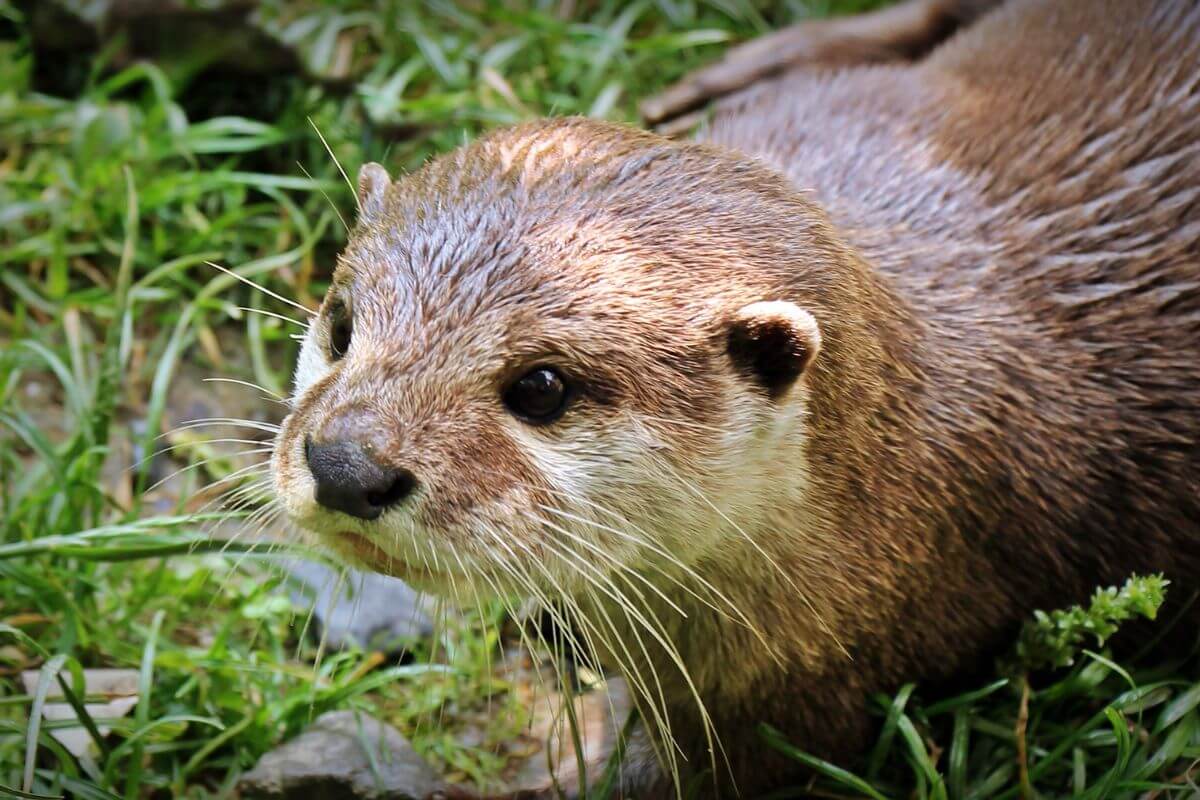
| Characteristic | Description |
|---|---|
| Weight | The adult Northern River Otter in Montana weighs around 20 pounds. |
| Length | The adult Northern River Otter in Montana measures close to 47 inches long, with the tail making up nearly 20 inches. |
| Tail | The Northern River Otter has a thick, powerful tail that makes up nearly 20 inches of their length. |
| Body Features | The Northern River Otter has small eyes and ears, a broadly flattened head, a long cylindrical form, and four webbed feet. |
| Fur | The Northern River Otter’s fur is dark brown on top and silvery or paler brown on the throat, chest, and underside. |
| Legs | The Northern River Otter has short, muscular legs. |
| Teeth | The Northern River Otter has 36 teeth. |
Montana is home to the Northern River Otters (Lontra Canadensis), a species that thrives in the state’s diverse waterways and offers a glimpse into the region’s rich wildlife. These otters have unique characteristics that suit their aquatic lifestyle and the challenging Montana climate.
Montana’s Northern River Otters are so fascinating because they are:
- Well-Adapted to the Cold – Otters’ long guard hairs are remarkable, they stay flexible even in the coldest weather. Plus, the dense underfur is a natural insulator in the water, keeping them warm.
- Diving Masters – Capable of diving up to 45 feet and staying submerged for extended periods, these otters are well-equipped for underwater hunting.
- Night Dwellers – During the summer, otters are more active at night. Their eyes have a unique quality — they reflect a subtle amber glow in the dark.
- Wanderers – While otters are great swimmers, don’t be surprised to see them traveling on land. Their ability to move on land is quite impressive.
- Social Animals – Otters are often spotted in pairs as they’re not just companions but also help each other with hunting and raising their young.
- River Dwellers – Otters’ ideal habitat includes waters with high flow, lots of vegetation, and spots with sloughs and side channels for raising their young. These areas are crucial for their survival, both in summer and winter.
- Fish Lovers – Fish is the otters’ primary food source, with a preference for certain types like sunfish, suckers, and trout. They also eat invertebrates and frogs, depending on what’s available.
- Infrequent Breeders – Otters likely breed every 2 to 3 years, with weaning of the pups starting in July and early August. This period is crucial for the young otters as they learn essential skills like swimming and hunting from their mothers.
Montana’s otters play a significant role in the circle of life. They are considered an indicator species, meaning their well-being reflects the health of the overall ecosystem. This highlights the importance of studying and protecting otter populations in Montana.
Despite their adaptability and unique traits, Northern River Otters face challenges, including human-caused threats and being inadvertently caught in beaver sets. Understanding and protecting these amazing creatures is not just about them. It’s about ensuring the balance and health of Montana’s rivers and wildlife.
Where to See Montana Otters
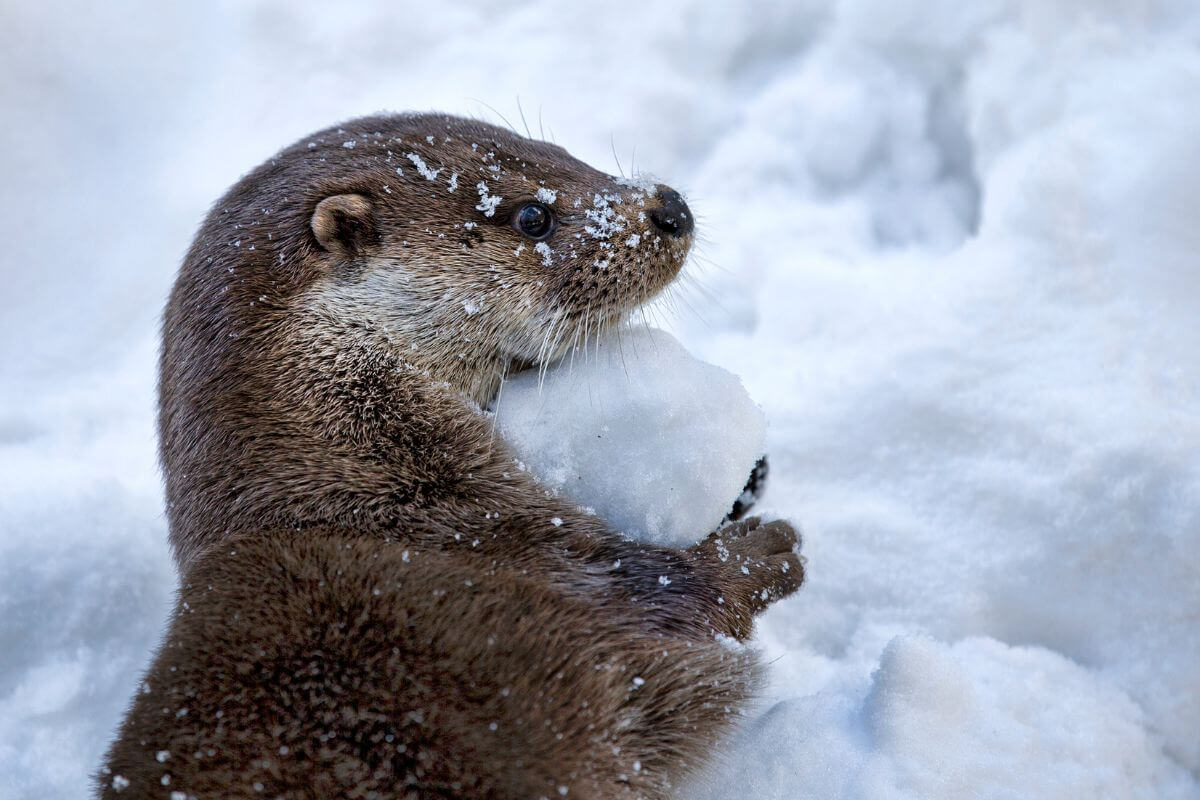
Montana offers unique opportunities to see otters in their natural habitat. These playful creatures can be spotted in various locations nationwide, delighting wildlife enthusiasts and nature lovers. Knowing where to look increases your chances of witnessing these fascinating animals.
1. Grizzly & Wolf Discovery Center
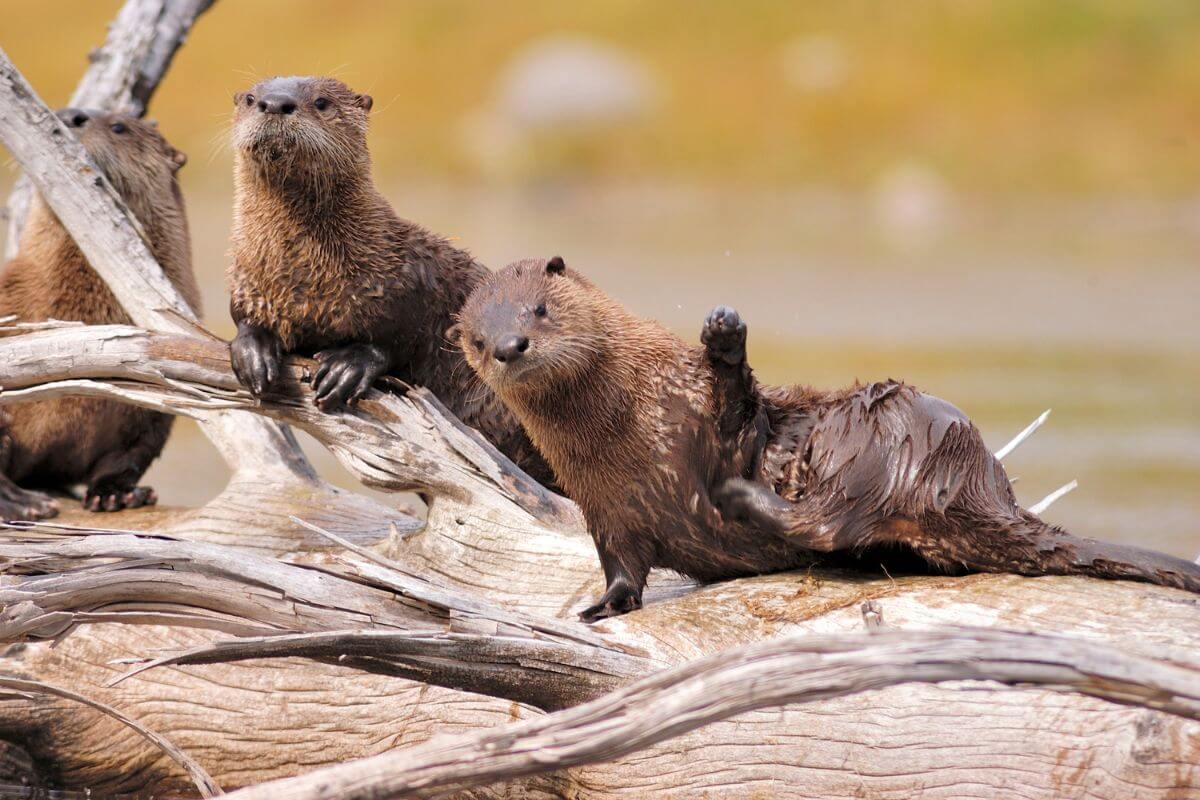
The Grizzly & Wolf Discovery Center in West Yellowstone, Montana, stands out where nature meets education. It’s not just a wildlife park, it’s a learning hub right next to the west entrance of Yellowstone National Park. In its Banks of the Yellowstone exhibit, you can see North American River Otters up close.
What makes the Grizzly & Wolf Discovery Center so special when it comes to otters?
- Meet the Otters – The otters you’ll see are part of a rotation. This means they get to spend time in the public viewing area, playing and swimming, and have their chill-out spaces backstage.
- Enrichment Activities – Thanks to the animal keepers, the otters’ habitat grows with new things to play with and explore throughout the day. This keeps the otters mentally and physically sharp, tapping into their natural curiosity and love for play.
Get to know the otters at Grizzly & Wolf Discovery Center:
- Aspen and Willow – Aspen and Willow are two female otters from the Pittsburgh Zoo. Aspen is known for her problem-solving skills. On the other hand, Willow loves a good sunny spot for napping and playful water adventures.
- Cliff and Wade – Cliff and Wade are male otters with their own stories. Cliff is a charmer who arrived with his brother from another wildlife facility. Wade was born in ZooMontana and is a curious explorer, always looking for new things in his habitat.
- Moe – Moe is the newest otter at the center of the Woodland Park Zoo in Seattle. He’s a confident swimmer and forager and loves checking out the cool enrichment items.
Watching the otters at the Grizzly & Wolf Discovery Center isn’t just about seeing cute animals. It’s a chance to understand the importance of wildlife conservation and how we can help protect otters and their natural habitats.
2. ZooMontana
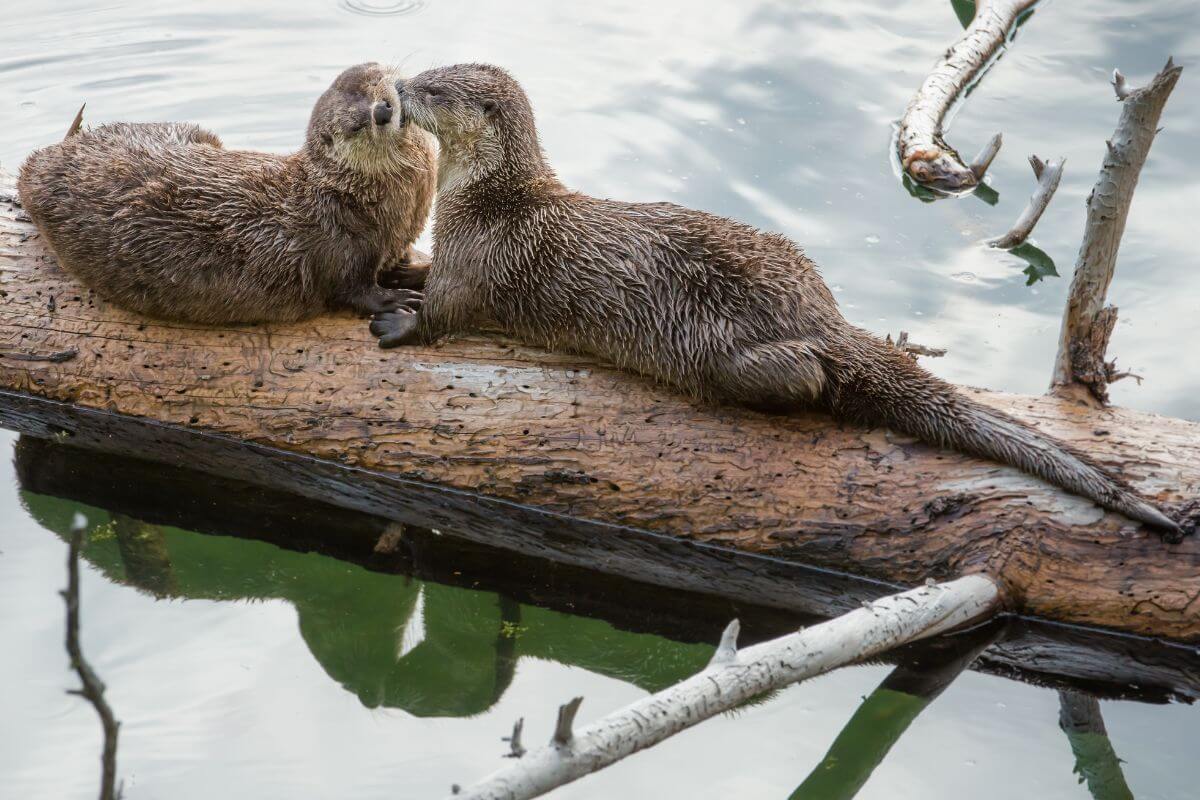
ZooMontana in Billings is not your average zoo. It’s a place where education and conservation meet, surrounded by the beauty of a botanical garden and the knowledge of an accredited arboretum. This unique facility is home to three special otters: Benjamin, Amelia, and their son Sam.
Who are the otters at ZooMontana?
- Benjamin and Amelia – Benjamin and Amelia’s story is about resilience and learning to swim. They came to ZooMontana in 2009 as pups, facing challenges with a local fishery. Thanks to the dedicated zookeepers, they overcame their initial fear of water. Today, they enjoy various enrichment activities, from puzzle feeders to exploring logs with different scents.
- Sam – Born in 2018, Sam faced a different beginning. As one of the ‘fab four’ otters born unexpectedly, he and his siblings needed special care after Amelia abandoned them. Hand-raised by the zookeepers, Sam now serves as an ambassador for his species. While two of his siblings are on loan to another center, Sam remains at ZooMontana, delighting visitors with his playful nature.
At ZooMontana, these otters have more than just a place to swim. They have two ponds, perfect for a dip even in the coldest months, and plenty of cozy spots for napping. This setup lets visitors see the otters in their element, whether playing in the water or napping in the sun.
3. Montana National Parks
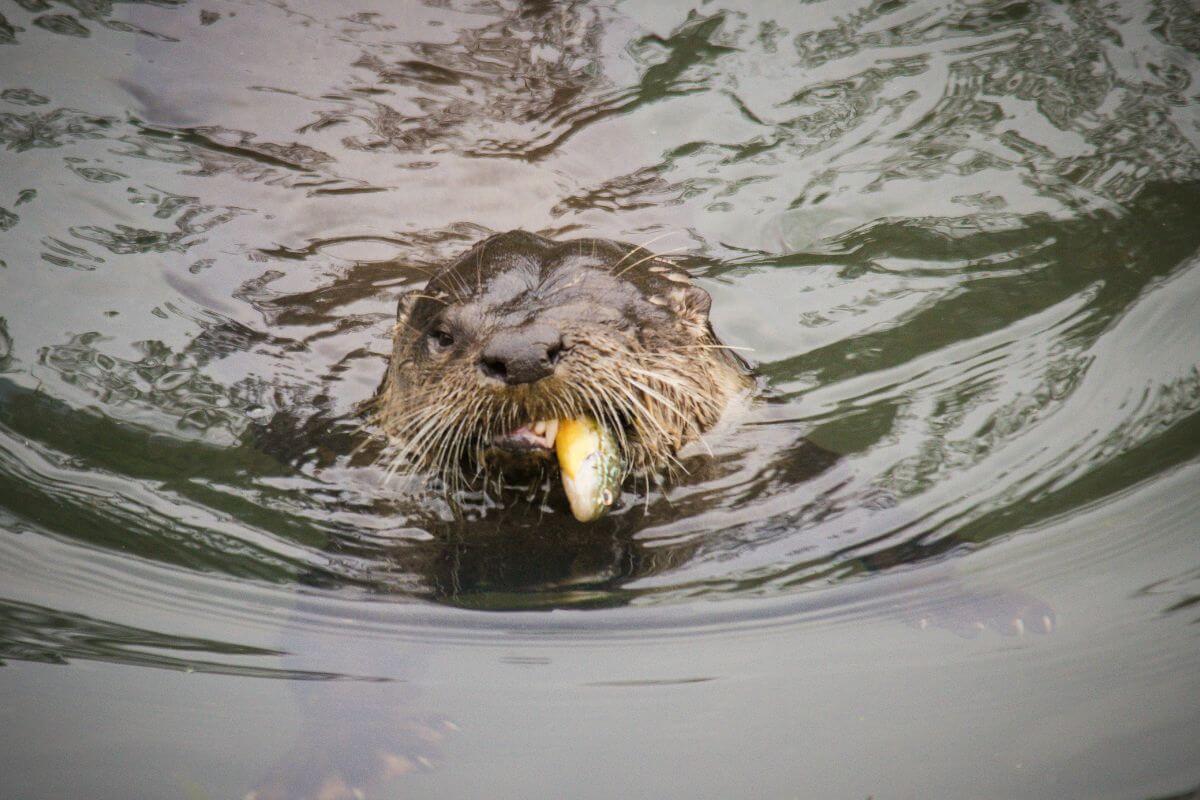
| National Park | Best Spots for River Otter Sightings |
|---|---|
| Glacier National Park | Lake McDonald and Swiftcurrent Lake |
| Yellowstone National Park | Yellowstone River, Lamar River, Yellowstone Lake |
Montana’s Glacier National Park is a haven for wildlife, including lively river otters. With its clear lakes, winding rivers, and rich wetlands, the park’s vast expanse of untouched nature offers the perfect home for these playful creatures. In particular, Lake McDonald and Swiftcurrent Lake stand out for spotting river otters going about their day.
Famous for its geysers and hot springs, Yellowstone National Park is another key spot for river otters in Montana. The otters take advantage of the park’s many waterways, such as the Yellowstone River, the Lamar River, and the expansive Yellowstone Lake.
Visitors to Yellowstone are often treated to the sight of otters swimming, diving, and fishing along the park’s shores. The added feature of geothermal areas in the park makes for a unique environment where these fascinating animals live and thrive.
4. Montana Rivers and Streams
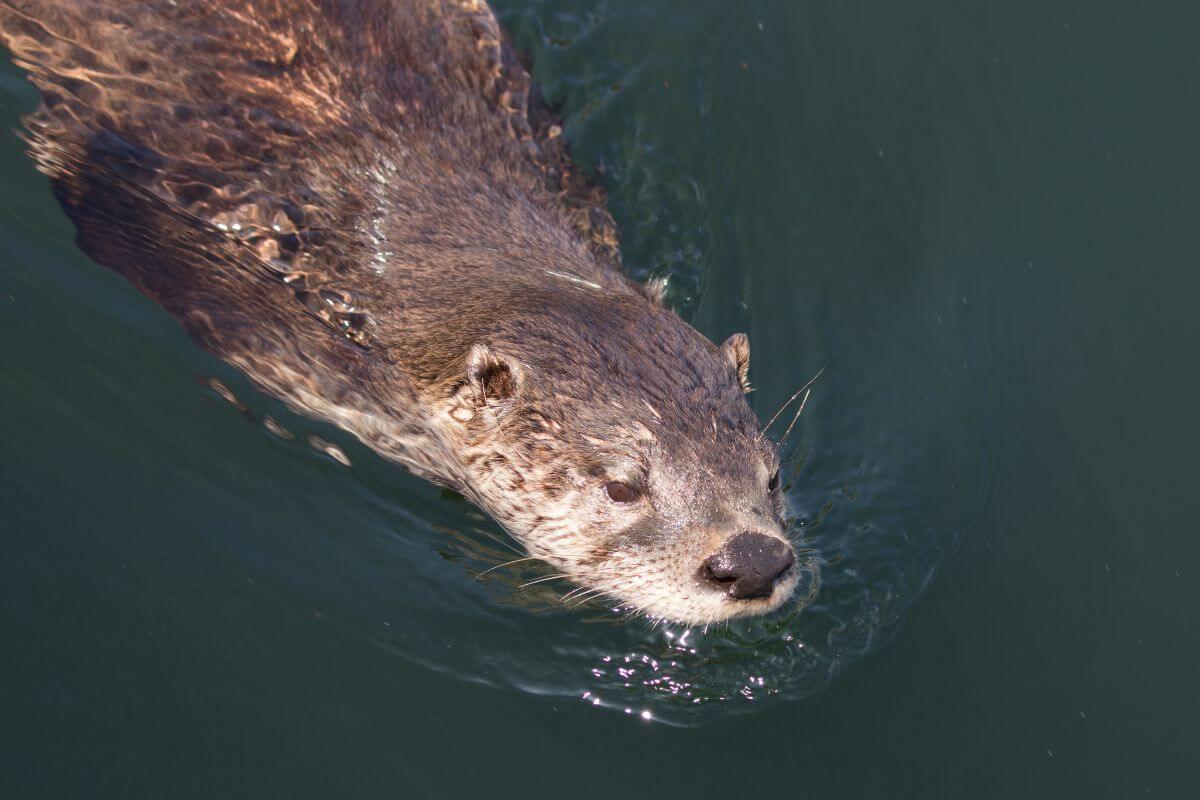
Montana’s rivers and streams are like bustling otter highways, perfect for these playful creatures to call home. Why do otters love Montana’s streams and rivers?
- Ideal Otter Homes – Montana’s rivers and streams are rich with fish, crayfish, and other tasty treats for otters. This makes the upper Missouri River and its buddies, the Smith River and Sun River, top spots for otters to live.
- A Peek into Otter Life – People who enjoy fishing or paddling in these waters get a special treat. They often get to see otters in action, playing and hunting. It’s a real-life, wild otter show from your canoe or fishing spot.
Montana’s rivers and streams are beautiful and vital homes for otters, offering a peek into the natural world that many of us only dream about.
5. Montana Lakes and Other Bodies of Water
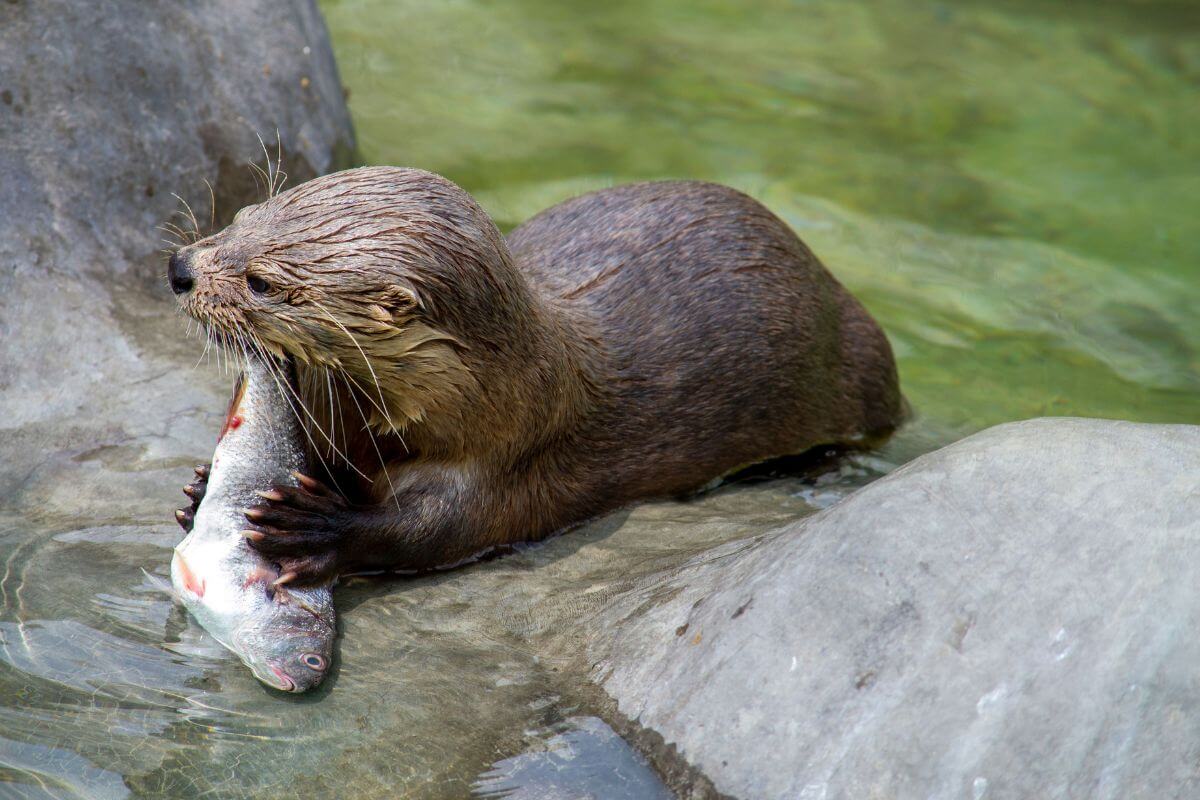
Montana’s network of lakes and waterways is more than just scenic, it’s a vital home for river otters. These playful creatures thrive in the state’s watery landscapes, thanks to places like Flathead Lake.
What makes Montana’s lakes the ideal habitat for otters?
- Flathead Lake – This vast, fish-filled lake is the largest natural freshwater lake in the western U.S. Its stunning mountain backdrop makes it a perfect spot for otters with plenty to eat and a beautiful place to live.
- Wetlands and Marshes – Montana’s otters also rely on wetlands, marshes, and beaver ponds. Places like the Red Rock Lakes National Wildlife Refuge are like otter supermarkets, full of tasty fish and safe spaces for families.
These water habitats are not just pretty scenes. They are the lifeblood of otter communities, offering everything they need to survive and thrive.
Tips for Watching Otters in Montana
Watching otters in Montana is a special experience, but it comes with a challenge: these creatures are masters of staying out of sight. Check out these tips for observing otters in Montana while respecting their space and other wildlife:
- Best Times for Otter Watching – Otters are most active in the early morning and late evening. This means dawn and dusk are the best times to watch them play and hunt.
- Be Patient and Quiet – Otters are shy, so patience and quiet are key. Keep a good distance and observe silently. This way, you won’t scare them off and might see some cool otter behaviors.
- Where to Look – Near rivers and lakes is where otters hang out. Look for their slides (where they enter the water), tracks, or scat (poop) along the shore. These are signs that otters are around.
- Tools for Watching – Binoculars and cameras with zoom lenses are super helpful. They let you watch from a safe distance without getting too close. Remember, we want to see the otters but don’t want to bother them.
- Respect Their Space – Like all wildlife, otters have their own territory. It’s important to give them room to live naturally. Don’t try to touch them or feed them. Watching from a distance is the best way to enjoy their company.
- Stay Safe – If you do encounter otters, keep your distance. It’s rare, but an otter might defend itself if threatened. In that case, follow the advice from Montana Fish, Wildlife & Parks (FWP): fight back, get out of the water, and seek medical help if injured.
Watching otters is a real treat, but it comes with responsibilities. By being a considerate observer and following these tips, you can enjoy the beauty of Montana’s otters while keeping them safe and wild.
Otter Attacks in Montana
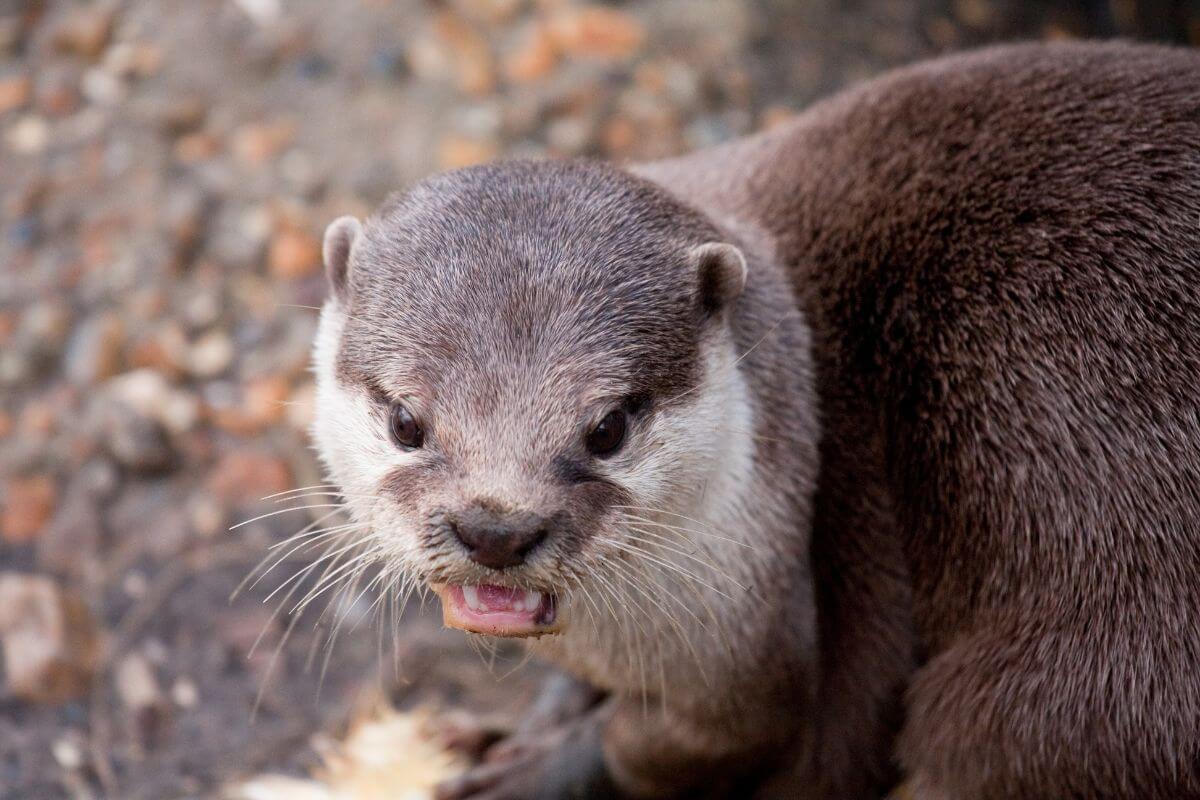
Otter attacks in Montana are incredibly rare. Despite their playful nature, otters can become aggressive when they feel threatened. In the entire world, there have only been 59 documented otter attacks since 1875. Yes, you read that right, 59 in almost 150 years.
The Montana FWP records very few otter attacks in Montana, where river otters thrive. One incident happened in 2021 on the Big Hole River.
In August 2023, a notable otter attack took place on the Jefferson River in Montana, involving three women, Jen Royce and two friends.
During the incident, Jen Royce was bitten by the otter on multiple parts of her body including her face, arms, ears, hands, legs, and ankles. Despite a brief struggle, the women managed to escape to shore, prompting the otter to swim away once the perceived threat had passed.
This incident reminds us that otters have limits, though usually peaceful. They will fight to protect themselves, their families, and their homes. That’s why the Fish, Wildlife, and Parks Department puts up signs in places where otters are known to live and asks people to be careful.
If you see one of these signs, it’s not a reason to panic. It’s just a heads-up that otters are around, and giving them their space is best. If you’re fishing or doing some other activity they might see as a challenge, they could get defensive.
Remember, otters are not out to get you. They just want to live their lives in peace. If we look out for each other, humans and otters can share the rivers happily.
Montana Otters Final Thoughts
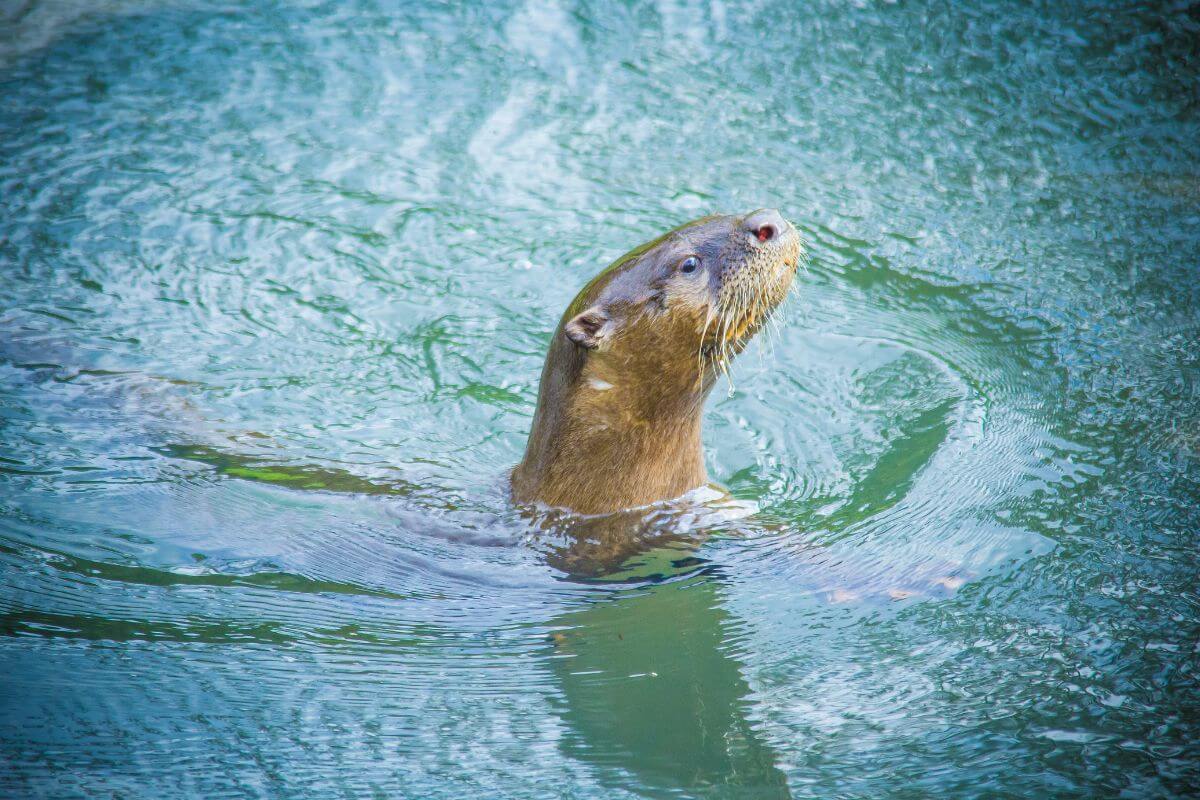
Montana’s Northern River Otters are more than just wildlife — they symbolize nature’s resilience in challenging climates. Their ability to thrive in Montana’s diverse waterways showcases the state’s commitment to preserving natural beauty.
As we marvel at these otters’ cold-defying fur and their skills as expert divers, we’re reminded of their crucial role as indicator species. Studying and protecting them isn’t just about their well-being, it’s about ensuring the balance and health of Montana’s entire ecosystem.
Montana has various spots, like wildlife centers and national parks, where you can see otters in the wild. To make the most of your experience, remember the best times to watch, stay quiet, and bring the right gear.
While otter attacks are rare, respecting their space is key to peaceful coexistence. By following these guidelines, we can spend time with Montana’s otters and gain a greater appreciation for the state’s natural beauty.
Montana Otters FAQs
1. Are There Otters in Montana?
There are otters in Montana. North American river otters (Lontra canadensis) inhabit various aquatic habitats throughout the state, including rivers, streams, lakes, and wetlands.
2. Where Was the Otter Attack in Montana?
The recent attack in Montana happened in August of 2023 on the Jefferson River near the Lewis and Clark Caverns.
3. How Big Are Montana Otters?
In Montana, North American river otters typically weigh between 10 to 30 pounds (4.5 to 13.6 kilograms) and measure around 2 to 3 feet (0.6 to 0.9 meters) in length, excluding their tail.
4. Do Otters Live in Yellowstone?
Otters can be found in Yellowstone National Park. While not as commonly observed as other wildlife species in the park, otters inhabit various aquatic habitats within Yellowstone, including rivers, streams, lakes, and wetlands.
5. Does Montana Have Raccoons?
Montana does have raccoons (Procyon lotor). Raccoons are found throughout much of the state, particularly in riparian areas, forests, and urban or suburban environments where they can find suitable habitats and food sources.
Experience Montana’s wonders by reading the articles below:

